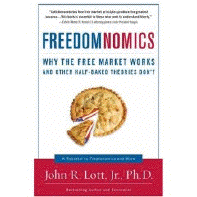
Freedomnomics
William McRaven, chancellor of the University of Texas System, has weighed in heavily against allowing permitted concealed handguns on college campus.
But other than fears about safety and difficulties in recruiting and retaining quality faculty, he has offered no evidence to support his claims.
Texas has joined at least nine states allow permitted concealed handguns on college campuses: Colorado, Idaho, Kansas, Michigan, Mississippi, Oregon, Utah and Wisconsin, and public universities in Pennsylvania, outside the Penn State system, mandate concealed-carry on campuses.
Public universities in Florida and Kentucky let permit-holders keep guns in their cars on campuses. Another 22 states leave gun policies up to individual schools.
Yet despite all this experience, McRaven fails to come up with hard evidence of any problems.
Has any of these states experienced an exodus of faculty? No. Have his concerns about “an increase in both accidental shootings and self-inflicted wounds” been realized? No.
Over all the years that states have allowed permitted concealed handguns on campus, there have been a total of just four accidents, none of them life-threatening and three of the four involving just minor injuries.
With more than 800,000 concealed-handgun permit-holders in Texas, there’s a good chance someone next to you in a grocery store or restaurant is carrying one.
Across the country, permit-holders are incredibly law-abiding and fewer than a thousandth of 1% lose their permits for any firearms-related violation.
In Texas and other states with permit-issuance and revocation data, college-age permit-holders turn out to be at least as law-abiding as others.
McRaven asserts that the University of Texas system already has done what’s necessary to ensure safety by using emergency notification systems and having campus police. However, even if victims are able to call police, under the best of circumstances, response times will probably be no faster than five or six minutes.
The main security problem is never mentioned: Attackers have the strategic advantage of choosing where and when to attack. Since the officers are in uniform, potential killers can either kill the officers first, wait for the officers to leave the area before attacking or pick another target.
McRaven worries that suicides will increase but ignores the fact that permit-holders have much lower suicide rates than the general population. In Michigan, the rate for permit-holders is just 37% that for the general population.
In a recent survey of North American economists who have published peer-reviewed research on firearms, 72% do not believe the presence of a gun increases the risk of suicide. If someone wants to commit suicide, there are many ways for them to do it.
University law enforcement personnel are said to oppose permitted concealed handguns, worrying about “the ability of our officers to differentiate between the bad actor and persons seeking to defend themselves.”
For mass public shootings, there’s not a single example of a police officer accidentally shooting a permit-holder or in which permit-holders have accidentally shot a bystander.
PoliceOne, the largest private organization of law enforcement officials in the U.S., with over 450,000 members, surveyed its members and found that in “tragedies like Newtown (Ct.) and Aurora (Colo.) Ö a legally armed citizen” would likely have reduced the casualties.
Attempts to ban guns from areas simply mean it’s the law-abiding victims who are unarmed. Instead of making places safe for victims, they’re made safe for the attackers.
• Lott is the president of the Crime Prevention Research Center and the author of "More Guns, Less Crime" (University of Chicago Press, 2010).

Article published Friday, June 2, 2015, at Investor's Business Daily.
Chancellor Fires Blanks At Texas College Campus Carry Law
By John R. Lott, Jr.
|
Home
Johnlott.org
(description of book, downloadable data sets, and discussions of previous controversies)
Academic papers:
Social Science Research Network
Book Reviews:
For a list of book reviews on The Bias Against Guns, click here.
---------------------------------
Posts by topic
Fraudulent website pretending to be run by me
The Merced Pitchfork Killings and Vin Suprynowicz's quote
Mother Jones article
Links
Interview with National Review Online
Lyonette Louis-Jacques's page on Firearms Regulation Worldwide
The End of Myth: An Interview with Dr. John Lott
Some data not found at www.johnlott.org:
Updated Media Analysis of Appalachian Law School Attack
Since the first news search was done additional news stories have been
added to Nexis:
There are thus now 218 unique stories, and a total of 294 stories counting
duplicates (the stories in yellow were duplicates): Excel file for
general overview and specific stories. Explicit mentions of defensive gun use
increase from 2 to 3 now.
Journal of Legal Studies paper on spoiled ballots during the 2000 Presidential Election
|